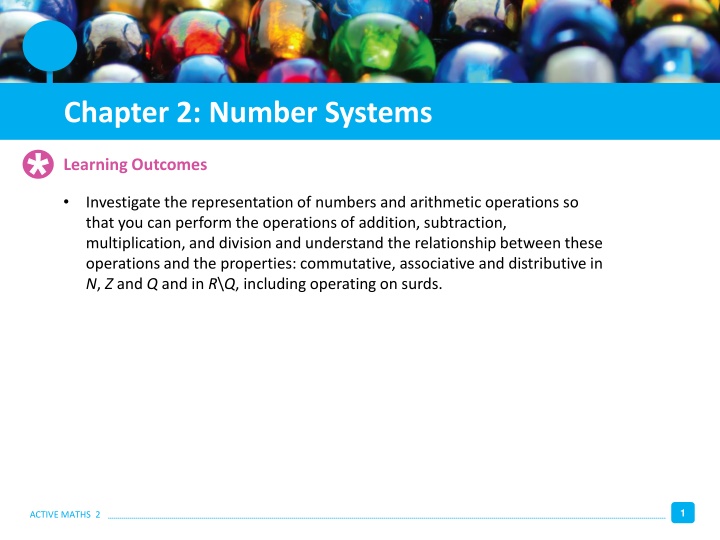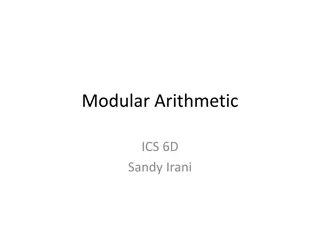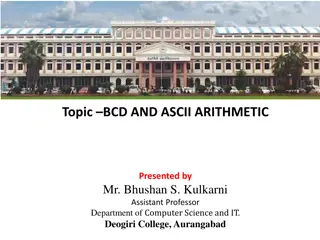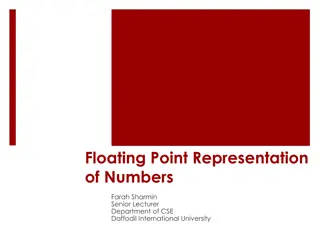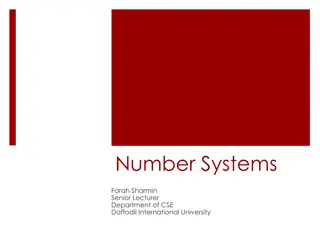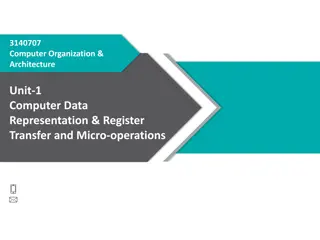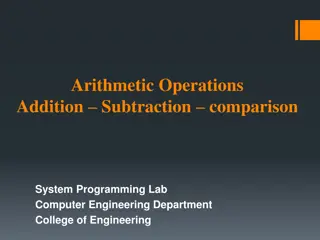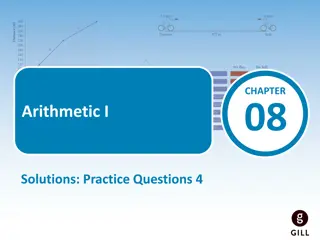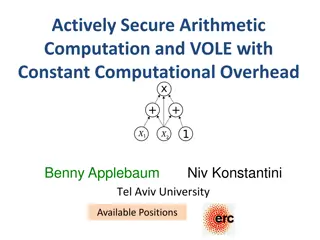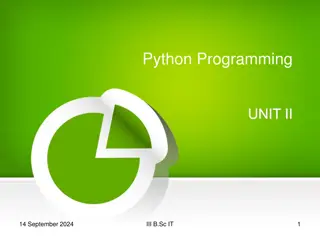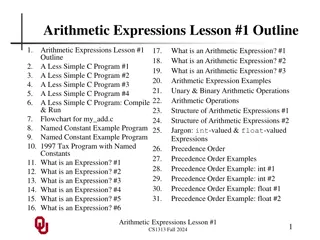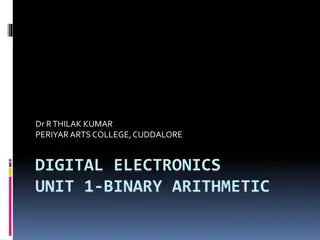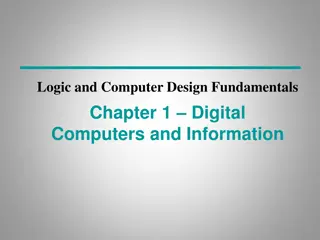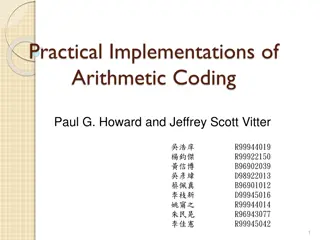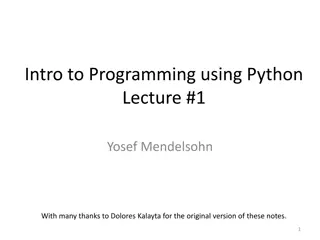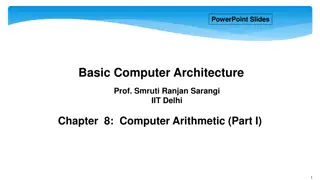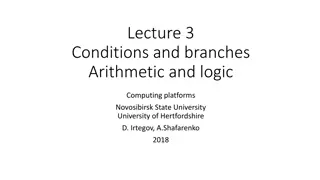Number Systems Representation and Arithmetic Operations
Delve into the representation of natural, integer, rational, irrational, and real numbers, along with key properties such as commutative, associative, and distributive. Explore the concept of irrational numbers and their place within the real number system. Understand the foundational principles that govern arithmetic operations, including addition, subtraction, multiplication, and division.
Download Presentation

Please find below an Image/Link to download the presentation.
The content on the website is provided AS IS for your information and personal use only. It may not be sold, licensed, or shared on other websites without obtaining consent from the author.If you encounter any issues during the download, it is possible that the publisher has removed the file from their server.
You are allowed to download the files provided on this website for personal or commercial use, subject to the condition that they are used lawfully. All files are the property of their respective owners.
The content on the website is provided AS IS for your information and personal use only. It may not be sold, licensed, or shared on other websites without obtaining consent from the author.
E N D
Presentation Transcript
Chapter 2: Number Systems Learning Outcomes Investigate the representation of numbers and arithmetic operations so that you can perform the operations of addition, subtraction, multiplication, and division and understand the relationship between these operations and the properties: commutative, associative and distributive in N, Z and Q and in R\Q, including operating on surds. 1 ACTIVE MATHS 2
Review: Revision of material from Active Maths 1 02 1. Natural numbers: The set of natural numbers is the set of counting numbers. They are also called the positive whole numbers. N = {1, 2, 3, 4, ...} 2. Integers: The set of integers is the set of natural numbers, their negatives and zero. Z = {..., 3, 2, 1, 0, 1, 2, 3, ...} 3. Rational numbers: The rational numbers are numbers that can be written in the form ? ? ,where ?, ? Z and ? 0. Q = {Any number of the form ? ? ,where ?, ? Z and ? 0. N Z Q A prime number is a natural number that has exactly two factors. 2 ACTIVE MATHS 2
The Commutative, Associative and Distributive Properties 02 If a, b, c N, then: (i) a + b = b + a (Addition is commutative) 3 + 4 = 4 + 3 (ii) a b = b a (Multiplication is commutative) 3 4 = 4 3 (iii) (a + b) + c = a + (b + c) (Addition is associative) 3 + 4 + 2 = 3 + 4 + 2 (iv) (a b) c = a (b c) (Multiplication is associative) 3 4 2 = 3 4 2 (v) a (b + c) = a b + a c (Multiplication distributes over addition) 2 3 + 4 = 2 3 + 2 4 3 ACTIVE MATHS 2
Irrational Numbers 02 The length ? of the diagonal of the unit square can be found using the theorem of Pythagoras. ? ? ?2= 12+ 12 ? 1 ?2= 1 + 1 ?2= 2 ? ? 1 ? = 2 (as ? > 0) 2 is bigger than 1 = 1 and smaller than 4 = 2. Therefore, 2 lies on the number line between 1 and 2. 1 and 2 are both rational. What about 2 ? A real number is any number that can be represented on the number line. It can be proved that 2 cannot be written as a ratio of integers (i.e. in the form ? ? ). We say that 2 is irrational. An irrational number is a real number that cannot be written in the form ? integer and ? is a non-zero integer. In other words, an irrational number is a real number that cannot be written as a ratio of integers. ?, where ? is an 4 ACTIVE MATHS 2
Real Numbers 02 The rational and irrational numbers together make up the real number system. Reals Irrationals Insert each of the following numbers in its correct region on the diagram below. (a) 3 4 (b) 3 (e) 144 2 (c) 5 (f) 8 (g) 14 2 (d) 5 2 (h) ? (i) 5? (j) 3 ? ?? ? ? ? ? ? ?? ? ??? ? ? 8 ? ? 5 ACTIVE MATHS 2
Surds 02 A surd is an irrational number that can be written as the root of a rational number. 2 and 3 are examples of surds. 38, 5 are surds? Which of the numbers 9,?, 9 is not a surd as 9 = 3, which is rational. ? is not a surd as ? cannot be written as the root of a rational number. 38 is not a surd. Although 38 is the cube root of a rational number, 38 = 2 which is rational. 5 is a surd as it is both irrational and can be written as the root of a rational number. 6 ACTIVE MATHS 2
Laws of Surds 02 Law 1: ? ? = ?? , ? 0,? 0 ? ?= ? ? , ? 0,? 0 Law 2: Law 3: ? ? = ?, ? 0 (a) Show that ? ? = ?? , if ? = ? and ? = ? ? ?= ? ? , if ? = 100 and ? = 25 (b) Show that (c) Show that ? ? = ?,if ? = 16 100 25=10 5= 2 (b) (a) 9 4 = 3 2 = 6 (c) 16 16 = 4 4 = 16 (9)(4) = 36 = 6 100 25= 4 = 2 7 ACTIVE MATHS 2
Adding, Subtracting and Reducing Surds 02 Reduce ?? to its simplest surd form. Step 1: Find the largest square number that is a factor of 45. 9 is the largest square factor of 45. 45 = 9 5 Step 2: = 9 5 = 3 5 Simplify ?? + ? ??, without the use of a calculator. 50 + 8 32 = 25 2 + 4 2 16 2 = 25 2 + 4 2 16 2 = 5 2 + 2 2 4 2 = 3 2 8 ACTIVE MATHS 2
Further Multiplication and Division 02 ? ? + ? ? + ? Use an area model to simplify the following: ? ? ? + ? (a) Form a rectangle that is subdivided into two smaller rectangles, as shown in the diagram: 1 1 7 7 3 3 21 3 3 7 + 1 = 21 + 3 (b) A rectangle is subdivided into four smaller rectangles, as shown in the diagram. 2 3 Summing the area of the four smaller rectangles gives the solution: 6 2 2 2 2 + 3 2 + 3 = 2 2 + 3 3 + 6 + 6 3 6 3 3 9 ACTIVE MATHS 2
Rationalising the Denominator 02 The method of eliminating a surd from the denominator in order to simplify an expression is known as rationalising the denominator. Simplify ? ? To rationalise the denominator, multiply both the numerator and denominator by 2. 1 1 2 2= 2 2 2 = 2 2 2 = 2 10 ACTIVE MATHS 2
